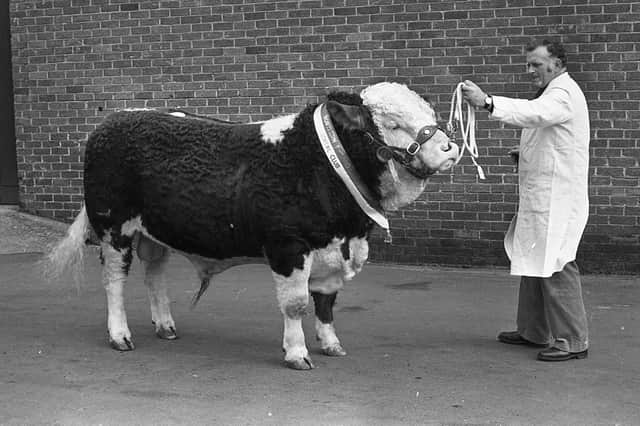BYGONE DAYS: Top honour for Ballynahinch farmer as he takes up club presidency


And, at 40, he shared with Mrs Willie McLaren of the Netherton herd in Scotland, the distinction of being the youngest breeder to be president.
To crown a memorable occasion, Mr Gabbie was also to be among the exhibitors at Perth, having made his debut in 1978 as senior vice-president.
SELECT HERD
Advertisement
Advertisement
Mr Gabbie ran a small, select herd of Aberdeen Angus which had brought him much fame, noted Farming Life.
The paper remarked: “Farming is his life for, in business, he is head of the agricultural department of the Northern Bank which, like the Clydesdale Bank in Scotland, is a subsidiary of the Midland Bank Group. This position brings him into contact with livestock farmers all over the UK and Eire.”
He had already started his banking career, noted Farming Life, when he went into the breeding of pedigree Aberdeen Angus.
“But the seeds of a successful future stockman had been sown during his boyhood, helping with the Dairy Shorthorns on his father’s farm, and later showing pedigree Suffolk sheep. All the time he was studying for the bank which he qualified to join in 1956,” commented Farming Life.
SUCCESSFUL DEBUT
Advertisement
Advertisement
Outside his career Mr Gabbie was “banking” on owning a herd of his own and two years later, at the age of 20, with a keen stockman’s eye, he took the plunge into pedigree breeding, “somewhat by chance”.
He went to a local pedigree breeder to buy a heifer for a fatstock show and also bought a pedigree Aberdeen Angus bull calf which cost him £60. Little more than six months later, he was proudly showing the bull at the Royal Ulster Spring Show at Balmoral, winning first in his class. To crown his debut the bull made 180 guineas, “a good price in those days”. He spent his profits quickly for, at the same sale, he bought an Angus heifer and shortly afterwards added a cow.
Success followed and within a few years he had built up a select herd of cows.
The young enthusiastic breeder was soon in the prizes – and the prices – in a big way, winning firsts at Balmoral and Dublin – and in classes of 20 to 30 bulls – whetting his appetite for top honours.
Advertisement
Advertisement
One of his first sires was a Wyndcrest bull – a son of Prospero of Charterhouse which was later exported to America – and this bull won the breed reserve championship at Balmoral.
SIZE AND QUALITY
He, then looking to the trend of size with quality, turned to the breeding line of Baron Remus of Tulnavert, and this helped achieve his ultimate goal.
Always on the quest for better and still better Angus bulls, he used semen from the noted Rambler of Newcroft which produced some useful heifers in the herd. A Rambler son was sold at Balmoral to a Scottish breeder who showed him in Perth, where he was third in his class and made 1,800 guineas - “more than four times his Balmoral price”.
Another son of Rambler was show by Mr Gabbie at Perth in February, 1978, making 1,200 guineas.
CONFIDENCE IN THE FUTURE
Advertisement
Advertisement
Semen from Propel of Addington, noted for liveweight gain as well as quality, was being used in the 1970s and a bull and heifer from the herd had been entered for the 1979 February sale at Perth, reported Farming Life.
Mr Gabbie was confident that there was “no serious threat” to the Aberdeen Angus as a quality beef producer. He remarked: “Provided, of course, breeders pay attention to size, but always linked with quality.”
He added: “The easy-calving feature will retain popularity with Friesian breeders and the ‘easy-keep’ asset will always ‘weigh’ with beef producers.”